Magnus Hirschfeld
| Magnus Hirschfeld | |
|---|---|
 Bust of Magnus Hirschfeld in the Schwules Museum, Berlin | |
| Born |
14 May 1868 Kolberg, Prussia |
| Died |
14 May 1935 (aged 67) Nice, France |
| Residence | Germany, France |
| Known for | Institut für Sexualwissenschaft, Scientific Humanitarian Committee |
Magnus Hirschfeld (14 May 1868 – 14 May 1935) was a Jewish German physician and sexologist educated primarily in Germany; he based his practice in Berlin-Charlottenburg. An outspoken advocate for sexual minorities, Hirschfeld founded the Scientific Humanitarian Committee. Historian Dustin Goltz characterized this group as having carried out "the first advocacy for homosexual and transgender rights".[1]
Early life
Hirschfeld was born in Kolberg (now Kołobrzeg, Poland) in an Ashkenazi Jewish family, the son of a highly regarded physician and 'Medizinalrat' Hermann Hirschfeld. In 1887–1888 he studied philosophy and philology in Breslau, then from 1888 to 1892 medicine in Strasbourg, Munich, Heidelberg, and Berlin. In 1892 he earned his doctoral degree.
After his studies, he traveled through the United States for eight months, visiting the World's Columbian Exposition in Chicago, and living from the proceeds of his writing for German journals. Then he started a naturopathic practice in Magdeburg; in 1896 he moved his practice to Berlin-Charlottenburg.
Sexual rights activism
Scientific Humanitarian Committee
Magnus Hirschfeld found a balance between practicing medicine and writing about his findings. After several years as a general practitioner in Magdeburg, in 1896 he issued a pamphlet, Sappho and Socrates, on homosexual love (under the pseudonym Th. Ramien). In 1897, Hirschfeld founded the Scientific Humanitarian Committee with the publisher Max Spohr, the lawyer Eduard Oberg, and the writer Franz Joseph von Bülow. The group aimed to undertake research to defend the rights of homosexuals and to repeal Paragraph 175, the section of the German penal code that since 1871 had criminalized homosexuality. They argued that the law encouraged blackmail. The motto of the Committee, "Justice through science", reflected Hirschfeld's belief that a better scientific understanding of homosexuality would eliminate social hostility toward homosexuals.
Within the group, some of the members rejected Hirschfeld's (and Ulrichs's) view that male homosexuals are by nature effeminate. Benedict Friedlaender and some others left the Scientific-Humanitarian Committee and formed another group, the "Bund für männliche Kultur" or Union for Male Culture, which did not exist long. It argued that male-male love is an aspect of virile manliness rather than a special condition.
Under Hirschfeld's leadership, the Scientific-Humanitarian Committee gathered over 5000 signatures from prominent Germans on a petition to overturn Paragraph 175. Signatories included Albert Einstein, Hermann Hesse, Käthe Kollwitz, Thomas Mann, Heinrich Mann, Rainer Maria Rilke, August Bebel, Max Brod, Karl Kautsky, Stefan Zweig, Gerhart Hauptmann, Martin Buber, Richard von Krafft-Ebing and Eduard Bernstein.
The bill was brought before the Reichstag in 1898, but was supported only by a minority from the Social Democratic Party of Germany. Hirschfeld considered what would, in a later era, be described as "outing": forcing out of the closet some of the prominent and secretly homosexual lawmakers who had remained silent on the bill. He arranged for the bill to be reintroduced and in the 1920s it began to make some progress, before the takeover of the Nazi Party ended hopes for such reform.
Eulenburg affair
Hirschfeld played a prominent role in the Harden–Eulenburg affair of 1906-09, which turned to be the most explosive sex scandal of Imperial Germany. During the libel trial in 1907 when General Kuno von Moltke sued the journalist Maximilian Harden after the latter had run an article accusing Moltke of having a homosexual relationship with the politically powerful Prince Philipp von Eulenburg, who was the Kaiser's best friend, Hirschfeld testified for Harden. Hirschfeld in his role as an expert witness testified that Moltke was gay, and thus what Harden had written was true.[2] The homosexual Hirschfeld-who passionately wanted to make homosexuality legal in Germany-believed that proving that Army officers like Moltke were gay would help his case for legalization, and as such he also testified that he believed there was nothing wrong with Moltke.[2]
Most notably, Hirschfeld testified that "homosexuality was part of the plan of nature and creation just like normal love."[3] Hirschfeld's testimony caused outrage all over Germany. The Die Vossische Zeitung newspaper condemned Hirschfeld in an editorial as "a freak who acted for freaks in the name of pseudoscience".[2] The Die Mūnchener Neuesten Nachrichten newspaper declared in an editorial: "Dr. Hirschfeld makes public propaganda under the cover of science which does nothing but poison our people. Real science should fight against this!".[2] A notable witness at the trial was Lilly von Elbe, the former wife of Moltke who testified that her husband had only made love to her twice in their entire marriage.[4] Elbe spoke with remarkable openness for the period of her sexual desires and her frustration with a husband who was only interested in having sex with Eulenburg.[5] Elbe's testimony was marked by moments of low comedy when it emerged that she had taken to attacking Moltke with a frying pan in vain attempts to make him have sex with her.[6] The fact that General von Moltke was unable to defend himself from his wife's attacks was taken as proof that he was deficient in his masculinity, which many saw as confirming his homosexuality. At the time, the subject of female sexuality was taboo, and Elbe's testimony was very controversial, with many saying that Elbe must in some way be mentally ill because of her willingness to acknowledge her sexuality.[7] At the time, it was generally believed that women should not have any sort of sexuality, and the idealized woman was seen as a "chaste" and "pure" in her asexuality. Letters to the newspapers at the time from both men and women overwhelmingly condemned Elbe for her "disgusting" testimony concerning her sexuality.[8] As an expert witness, Hirschfeld also testified that female sexuality was natural, and Elbe was just a normal woman who was in no way mentally ill.[2] After the jury ruled in favor of Harden, Judge Hugo Isenbiel was enraged by the jury's decision, which he saw as expressing approval for Hirschfeld. He overturned the verdict under the grounds that homosexuals "have the morals of dogs" and insisted that this verdict could not be allowed to stand.[2]
After that verdict was overturned, a second trial found Harden guilty of libel.[2] At the second trial, Hirschfeld again testified as an expert witness, but this time, he was much less certain than he had been at the first trial about Moltke's homosexuality.[9] Hirschfeld testified that Moltke and Eulenburg had an "intimate" friendship that was homoerotic in nature, but was not sexual as he had testified at the first trial.[10] Hirschfeld also testified that through he still believed that female sexuality was normal, but that Elbe was suffering from hysteria caused by a lack of sex, and so the court should discount her stories about a sexual relationship between Moltke and Eulenburg.[11] Hirschfeld had been threatened by the Prussian government with having his medical license revoked if he testified as an expert witness again along the same lines that he had at the first trial, and possibly prosecuted for violating Paragraph 175.[12] The trial was a libel suit against Harden by Moltke, but much of the testimony had concerned Eulenburg, whose status as the best friend of Wilhelm II meant that the scandal was threatening to bring in the Kaiser.[13] Moreover, far from bringing about increased tolerance as Hirschfeld had expected, the scandal had led to a major homophobic and anti-Semitic backlash, and Hirschfeld's biographer Elena Mancini speculated that Hirschfeld wanted to bring to an end an affair that was hindering rather helping the cause for gay rights.[14]
Because Eulenburg was a prominent anti-Semite and Hirschfeld was a Jew, during the affair, the völkisch movement came out in support of Eulenburg, whom they portrayed as an Aryan heterosexual framed by false allegations of homosexuality by Hirschfeld and Harden.[15] Various völkisch leaders, most notably the radical anti-Semitic journalist Theodor Fritsch used the Eulenburg affair as a chance to "settle the accounts" with the Jews, and as such, Hirschfeld as a homosexual and a Jew was vilified relentlessly by the völkisch newspapers.[16] Outside of Hirschfeld's house in Berlin, posters were affixed by völkisch activists which read "Dr. Hirschfeld A Public Danger: The Jews are Our Undoing!".[17] In Nazi Germany, the official interpretation of the Eulenburg affair was that Eulenburg was a straight Aryan whose career was destroyed by false claims of being gay by Jews like Hirschfeld.[15] After the scandal had ended, Hirschfeld concluded that, far from helping the gay rights movement as he hoped, the ensuing backlash had set back the movement.[18] The conclusion drawn by the German government was the opposite of the one that Hirschfeld wanted; the fact that prominent men like General von Moltke and Eulenburg were gay did not lead the government to repeal Paragraph 175 as Hirschfeld had hoped, and instead the government decided that Paragraph 175 was being enforced with insufficient vigor, leading to a crackdown on homosexuals that was unprecedented, and would not be exceeded until the Nazi era.[19]
World War I
In 1914, Hirschfeld was swept up by the national enthusiasm for Burgfrieden ("Peace within a castle under siege") as the sense of national solidarity was known where all almost Germans rallied to the Fatherland.[20] Initially pro-war, Hirschfeld started to turn against the war in 1915, moving towards a pacifistic position.[21] By 1916, Hirschfeld was writing pacifistic pamphlets calling for the immediate end of the war.[21]
Interwar period
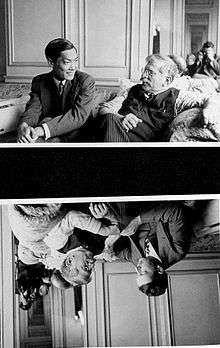
In 1921 Hirschfeld organised the First Congress for Sexual Reform, which led to the formation of the World League for Sexual Reform. Congresses were held in Copenhagen (1928), London (1929), Vienna (1930), and Brno (1932).
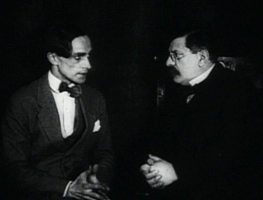
Hirschfeld was both quoted and caricatured in the press as a vociferous expert on sexual matters; during his 1931 tour of the United States, the Hearst newspaper chain dubbed him "the Einstein of Sex". He identified as a campaigner and a scientist, investigating and cataloging many varieties of sexuality, not just homosexuality. He developed a system which categorised 64 possible types of sexual intermediary ranging from masculine heterosexual male to feminine homosexual male, including those he described under the term transvestite (Ger. Transvestit), which he coined in 1910 to describe people who in the 21st century might be referred to as transgender or transsexual.
Anders als die Andern
Hirschfeld co-wrote and acted in the 1919 film Anders als die Andern ("Different From the Others"), in which Conrad Veidt played one of the first homosexual characters ever written for cinema. The film had a specific gay rights law reform agenda; after Veidt's character is blackmailed by a male prostitute, he eventually comes out rather than continuing to make the blackmail payments. His career is destroyed and he is driven to suicide.
Women's rights
In 1904, Hirschfeld joined the Bund für Mutterschutz (League for the Protection of Mothers), the feminist organization founded by Helene Stöcker. He campaigned for the decriminalisation of abortion, and against policies that banned female teachers and civil servants from marrying or having children.
Institut für Sexualwissenschaft
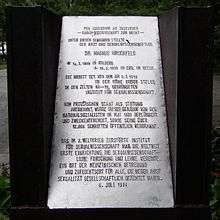
Under the more liberal atmosphere of the newly founded Weimar Republic, Hirschfeld purchased a villa not far from the Reichstag building in Berlin for his new Institut für Sexualwissenschaft (Institute of Sexual Research), which opened on 6 July 1919. The Institute housed Hirschfeld's immense archives and library on sexuality and provided educational services and medical consultations; the clinical staff included psychiatrists Felix Abraham and Arthur Kronfeld, gynecologist Ludwig Levy-Lenz, dermatologist and endocrinologist Bernhard Schapiro, and dermatologist Friedrich Wertheim.[22] The Institute also housed the Museum of Sex, an educational resource for the public, which is reported to have been visited by school classes.
People from around Europe and beyond came to the Institute to gain a clearer understanding of their sexuality. Christopher Isherwood writes about his and W. H. Auden's visit in his book Christopher and His Kind; they were calling on Francis Turville-Petre, a friend of Isherwood's who was an active member of the Scientific Humanitarian Committee. Other celebrated visitors included German novelist and playwright Gerhart Hauptmann, German artist Christian Schad, French writers René Crevel and André Gide, Russian director Sergei Eisenstein, and American poet Elsa Gidlow.[22]
In addition, a number of noted individuals lived for longer or shorter periods of time in the various rooms available for rent or as free accommodations in the Institute complex. Among the residents were Isherwood and Turville-Petre; literary critic and philosopher Walter Benjamin; actress and dancer Anita Berber; Marxist philosopher Ernst Bloch; Willi Münzenberg, a member of the German Parliament and a press officer for the Communist Party of Germany; Dörchen Richter, one of the first transgender patients to receive sex reassignment surgery at the Institute, and Lili Elbe.[22]
The Institute and Hirschfeld's work are depicted in Rosa von Praunheim's feature film Der Einstein des Sex (The Einstein of Sex, Germany, 1999; English subtitled version available). Although inspired by Hirschfeld's life, the film is fictional. It contains invented characters and incidents and attributes motives and sentiments to Hirschfeld and others on the basis of little or no historical evidence. Hirschfeld biographer Ralf Dose notes, for instance, that "the figure of 'Dorchen' in Rosa von Praunheim's film The Einstein of Sex is complete fiction."[22]
Later life and exile
When the Nazis took power, they attacked Hirschfeld's Institute on 6 May 1933, and burned many of its books as well as its archives (see Institut für Sexualwissenschaft).
By the time of the book burning, Hirschfeld had long since left Germany for a speaking tour that took him around the world; he never returned to Germany. In March 1932 he stopped briefly in Athens, spent several weeks in Vienna and then settled in Zurich, Switzerland in August 1932.[23] While there, he worked on a book recounting his experiences and observations from his world tour, published in 1933 as Die Weltreise eines Sexualforschers (Brugg, Switzerland: Bözberg-Verlag, 1933). It was published in an English translation in the United States under the title Men and Women: The World Journey of a Sexologist (New York City: G. P. Putnam's Sons, 1935) and in England under the title Women East and West: Impressions of a Sex Expert (London: William Heinemann Medical Books, 1935).
Hirschfeld had stayed near Germany, hoping to return to Berlin if the political situation improved. With the Nazi regime's unequivocal rise to power and with work completed on his tour book, he decided to go into exile in France. On his 65th birthday, 14 May 1933, Hirschfeld arrived in Paris, where he lived in a luxurious apartment building at 24 Avenue Charles Floquet, facing the Champ de Mars.[23] A year-and-a-half later, in November 1934 he moved south to Nice on the Mediterranean coast.[24] Throughout his stay in France, he continued researching, writing, campaigning and working to establish a French successor to his lost institute in Berlin.[23]
The last of Hirschfeld's books published during his lifetime, L'Ame et l'amour, psychologie sexologique [The Human Spirit and Love: Sexological Psychology] (Paris: Gallimard, 1935), was published in French in late April 1935;[25] it was his only book that was never published in a German-language edition. In the preface, he described his hopes for his new life in France:
In search of sanctuary, I have found my way to that country, the nobility of whose traditions, and whose ever-present charm, have already been as balm to my soul. I shall be glad and grateful if I can spend some few years of peace and repose in France and Paris, and still more grateful to be enabled to repay the hospitality accorded to me, by making available those abundant stores of knowledge acquired throughout my career.[26]
Death
.jpg)
.jpg)
On his 67th birthday, 14 May 1935, Hirschfeld died of a heart attack in his apartment at the Gloria Mansions I building at 63 Promenade des Anglais in Nice.[24] His body was cremated, and the ashes interred in a simple tomb in the Caucade Cemetery in Nice.[23] The upright headstone in gray granite is inset with a bronze bas-relief portrait of Hirschfeld in profile by German sculptor and decorative artist Arnold Zadikow (1884–1943), who like Hirschfeld was a native of the town of Kolberg. The slab covering the tomb is engraved with Hirschfeld's Latin motto, "Per Scientiam ad Justitiam" ("through science to justice").[22][27] (The Caucade Cemetery is likewise the location of the grave of surgeon and sexual-rejuvenation proponent Serge Voronoff — whose work Hirschfeld had discussed in his own publications.)
On 14 May 2010, to mark the 75th anniversary of Hirschfeld's death, a French national organization, the Mémorial de la Déportation Homosexuelle (MDH), in partnership with the new LGBT Community Center of Nice (Centre LGBT Côte d'Azur), organized a formal delegation to the cemetery. Speakers recalled Hirschfeld's life and work and laid a large bouquet of pink flowers on his tomb; the ribbon on the bouquet was inscribed "Au pionnier de nos causes. Le MDH et le Centre LGBT" ("To the pioneer of our causes. The MDH and the LGBT Center").[28]
Legacy
American Henry Gerber, attached to the Allied Army of Occupation following World War I, became impressed by Hirschfeld and absorbed many of the doctor's ideas. Upon his return to the United States, Gerber was inspired to form the short-lived Chicago-based Society for Human Rights in 1924, the first known gay rights organization in the nation.[29] In turn, a partner of one of the former members of the Society communicated the existence of the society to Los Angeles resident Harry Hay in 1929; Hay would go on to help establish the Mattachine Society in 1950, the first national homosexual rights organization to operate for many years in the United States.
In 1979, the Irish National Gay Federation established the Hirschfeld Centre, Ireland's first gay and lesbian community centre. Although badly damaged by a 1987 fire, the centre continued to house the Gay Community News magazine until 1997.[30]
In 1982, a group of German researchers and activists founded the Magnus Hirschfeld Society (Magnus-Hirschfeld-Gesellschaft e.V.) in West Berlin, in anticipation of the then-approaching 50th anniversary of the destruction of Hirschfeld's Institute for Sexual Science. Ten years later, the society established a Berlin-based center for research on the history of sexology.[31] The society's stated goals are the following:[31]
- To study the history of research on sexuality and gender, of the sexual reform movement and of related scholarly disciplines and life reform movements.
- To help establish research on sexuality and gender within academic institutions.
Since the late 20th century, researchers associated with the Magnus Hirschfeld Society have succeeded in tracking down previously dispersed and lost records and artifacts of Hirschfeld's life and work. They have brought together many of these materials at the society's archives in Berlin.[32][33] At an exhibition at the Schwules Museum in Berlin from 7 December 2011 to 31 March 2012, the society publicly displayed a selection of these collections for the first time.[34]
The German Society for Social-Scientific Sexuality Research established the Magnus Hirschfeld Medal in 1990. The Society awards the Medal in two categories, contributions to sexual research and contributions to sexual reform.
The Hirschfeld Eddy Foundation, established in Germany in 2007, is named for Hirschfeld and lesbian activist FannyAnn Eddy.
In August 2011, after 30 years of advocacy by the Magnus Hirschfeld Society and other associations and individuals, the Federal Cabinet of Germany granted 10 million euros to establish the Magnus Hirschfeld National Foundation (Bundesstiftung Magnus Hirschfeld), a foundation to support research and education about the life and work of Magnus Hirschfeld, the Nazi persecution of homosexuals, German LGBT culture and community, and ways to counteract prejudice against LGBT people; the Federal Ministry of Justice (Germany) was expected to contribute an additional 5 million euros, bringing the initial endowment of the foundation to a total of 15 million euros.[35][36][37]
Portrayals in popular culture
%3B_collection_of_Gerard_Koskovich_(San_Francisco).jpg)
Magnus Hirschfeld has been portrayed in a number of works of popular culture both during his lifetime and subsequently. Following is a sampling of genres and titles:
Caricature
Hirschfeld was a frequent target of caricatures in the popular press during his lifetime. Historian James Steakley reproduces several examples in his German-language book Die Freunde des Kaisers. Die Eulenburg-Affäre im Spiegel zeitgenössischer Karikaturen (Hamburg: MännerschwarmSkript, 2004). Additional examples appear in the French-language book Derrière "lui" (L'Homosexualité en Allemagne) (Paris: E. Bernard, [1908]) by John Grand-Carteret.
Film and television
- Different from the Others (Germany, 1919); directed by Richard Oswald; cowritten by Oswald and Magnus Hirschfeld. Hirschfeld appears in a cameo playing himself. Karl Giese, the young man who subsequently became Hirschfeld's lover, also had a part in the film.
- Race d'Ep: Un Siècle d'Images de l'Homosexualité (France, 1979); directed by Lionel Soukaz; cowritten by Soukaz and Guy Hocquenghem; released in the United States under the title The Homosexual Century. An experimental film portraying 100 years of homosexual history in four episodes, one of which focuses on Hirschfeld and his work. French gay writer Pierre Hahn played the role of Hirschfeld.[38][39][40]
- Desire: Sexuality in Germany, 1910–1945 (United Kingdom, 1989); directed by Stuart Marshall. A feature-length documentary tracing the emergence of the homosexual subculture and the homosexual emancipation movement in pre-World War II Germany—and their destruction by the Nazi regime.[41] According to film historian Robin Wood, Marshall "treats the burning of Hirschfeld's library and the closing of his Institute of Sexual Science as the film's...central moment...."[42]
- A segment on Hirschfeld appears in episode 19 of Real Sex, first shown on HBO on February 7, 1998.
- The Einstein of Sex (Germany, 1999); directed by Rosa von Praunheim. A fictional biopic inspired by Hirschfeld's life and work.
- Paragraph 175 (film) (USA, 2000); directed by Rob Epstein and Jeffrey Friedman (filmmaker). A feature-length documentary on the persecution of homosexuals during the Nazi regime. The first part of the film provides a brief overview of the history of the homosexual emancipation movement in Germany from the late-19th century through the early 1930s, with Hirschfeld and his work prominently featured.[42]
- Several episodes of the second season of the Amazon television series Transparent (USA, 2014-) include a portrayal of Hirschfeld and his institute. Hirschfeld is played by Bradley Whitford.
Fiction
- Robert Hichens (1939). That Which Is Hidden (London: Cassell & Company). U.S. Edition: New York: Doubleday, Doran & Company, 1940. The novel opens with the protagonist visiting the tomb of a famed Austrian sex expert, Dr. R. Ellendorf, in a cemetery in Nice. At the tomb, he meets the late doctor's protégé, a Chinese student named Kho Ling. The character of Ling refers to the memory of his mentor at numerous points in the novel. From the description of the settings and the characters, Ellendorf clearly was inspired by Hirschfeld, and Ling by Hirschfeld's last partner and heir, Li Shiu Tong (Tao Li).[43]
- Arno Schmidt. Zettels Traum (1970). Hirschfeld is quoted often in this novel about sexuality.
- Nicolas Verdan (2011). Le Patient du docteur Hirschfeld (Orbe, Switzerland: Bernard Campiche). A French-language spy thriller inspired by the sacking of Hirschfeld's Institute for Sexual Science by the Nazis.
Works
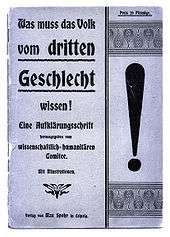
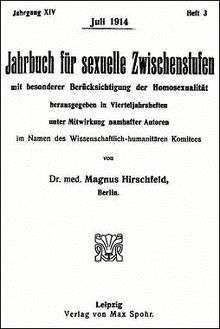
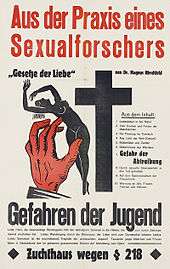
Hirschfeld's works are listed in the following bibliography, which is extensive but not comprehensive:
- Steakley, James D. The Writings of Magnus Hirschfeld: A Bibliography. Toronto: Canadian Gay Archives, 1985.
The following have been translated into English:
- The Transvestites: The Erotic Drive to Cross-Dress (1910), Prometheus Books; translated by Michael A. Lombardi-Nash (1991).
- Homosexuality of Men and Women (1914);[44] translated by Michael A. Lombardi-Nash, 2000 [45]
- The Sexual History of the World War (1930), New York City, Panurge Press, 1934; significantly abridged translation and adaptation of the original German edition: Sittengeschichte des Weltkrieges, 2 vols., Verlag für Sexualwissenschaft, Schneider & Co., Leipzig & Vienna, 1930. The plates from the German edition are not included in the Panurge Press translation, but a small sampling appear in a separately issued portfolio, Illustrated Supplement to The Sexual History of the World War, New York City, Panurge Press, n.d.
- Men and Women: The World Journey of a Sexologist (1933); translated by O. P. Green (New York City: G. P. Putnam’s Sons, 1935).
- Sex in Human Relationships, London, John Lane The Bodley Head, 1935; translated from the French volume L'Ame et l'amour, psychologie sexologique (Paris: Gallimard, 1935) by John Rodker.
- Racism (1938), translated by Eden and Cedar Paul. This denunciation of racial discrimination was not influential at the time, although it seems prophetic in retrospect.[46]
- Autobiographical
- Hirschfeld, Magnus. Von einst bis jetzt: Geschichte einer homosexuellen Bewegung 1897-1922. Schriftenreihe der Magnus-Hirschfeld-Gesellschaft Nr. 1. Berlin: rosa Winkel, 1986. (Reprint of a series of articles by Hirschfeld originally published in Die Freundschaft, 1920–21).
- M.H. [Magnus Hirschfeld], "Hirschfeld, Magnus (Autobiographical Sketch)," in Victor Robinson, Encyclopaedia Sexualis, New York City: Dingwall-Rock, 1936, pp. 317–321.
See also
- Der Eigene: world's first gay journal, Berlin, 1896–1932
- Arthur Kronfeld: collaborator of Magnus Hirschfeld, 1919–1926
Notes
- ↑ Goltz, Dustin (2008). "Lesbian, Gay, Bisexual, Transgender, and Queer Movements", In Lind, Amy; Brzuzy, Stephanie (eds.). Battleground: Women, Gender, and Sexuality: Volume 2, pp. 291 ff. Greenwood Publishing Group, ISBN 978-0-313-34039-0
- 1 2 3 4 5 6 7 Mancini, Elena Magnus Hirschfeld and the Quest for Sexual Freedom: A History of the First International Sexual Freedom Movement, London: Macmillan, 2010 page 100
- ↑ Domeier, Norman The Eulenburg Affair: A Cultural History of Politics in the German Empire, Rochester: Boydell & Brewer, 2015 page 128.
- ↑ Domeier, Norman The Eulenburg Affair: A Cultural History of Politics in the German Empire, Rochester: Boydell & Brewer, 2015 page 103.
- ↑ Domeier, Norman The Eulenburg Affair: A Cultural History of Politics in the German Empire, Rochester: Boydell & Brewer, 2015 pages 103-104
- ↑ Domeier, Norman The Eulenburg Affair: A Cultural History of Politics in the German Empire, Rochester: Boydell & Brewer, 2015 page 104
- ↑ Domeier, Norman The Eulenburg Affair: A Cultural History of Politics in the German Empire, Rochester: Boydell & Brewer, 2015 pages 103-105.
- ↑ Domeier, Norman The Eulenburg Affair: A Cultural History of Politics in the German Empire, Rochester: Boydell & Brewer, 2015 pages 103-105.
- ↑ Mancini, Elena Magnus Hirschfeld and the Quest for Sexual Freedom: A History of the First International Sexual Freedom Movement, London: Macmillan, 2010 page 101.
- ↑ Mancini, Elena Magnus Hirschfeld and the Quest for Sexual Freedom: A History of the First International Sexual Freedom Movement, London: Macmillan, 2010 page 101.
- ↑ Mancini, Elena Magnus Hirschfeld and the Quest for Sexual Freedom: A History of the First International Sexual Freedom Movement, London: Macmillan, 2010 page 101.
- ↑ Mancini, Elena Magnus Hirschfeld and the Quest for Sexual Freedom: A History of the First International Sexual Freedom Movement, London: Macmillan, 2010 page 101.
- ↑ Mancini, Elena Magnus Hirschfeld and the Quest for Sexual Freedom: A History of the First International Sexual Freedom Movement, London: Macmillan, 2010 page 101.
- ↑ Mancini, Elena Magnus Hirschfeld and the Quest for Sexual Freedom: A History of the First International Sexual Freedom Movement, London: Macmillan, 2010 page 101.
- 1 2 Domeier, Norman The Eulenburg Affair: A Cultural History of Politics in the German Empire, Rochester: Boydell & Brewer, 2015 page 169
- ↑ Domeier, Norman The Eulenburg Affair: A Cultural History of Politics in the German Empire, Rochester: Boydell & Brewer, 2015 pages 169-170
- ↑ Mancini, Elena Magnus Hirschfeld and the Quest for Sexual Freedom: A History of the First International Sexual Freedom Movement, London: Macmillan, 2010 page 101
- ↑ Domeier, Norman The Eulenburg Affair: A Cultural History of Politics in the German Empire, Rochester: Boydell & Brewer, 2015 page 139
- ↑ Domeier, Norman The Eulenburg Affair: A Cultural History of Politics in the German Empire, Rochester: Boydell & Brewer, 2015 pages 103-104
- ↑ Mancini, Elena Magnus Hirschfeld and the Quest for Sexual Freedom: A History of the First International Sexual Freedom Movement, London: Macmillan, 2010 page 111
- 1 2 Mancini, Elena Magnus Hirschfeld and the Quest for Sexual Freedom: A History of the First International Sexual Freedom Movement, London: Macmillan, 2010 page 112
- 1 2 3 4 5 Ralf Dose, Magnus Hirschfeld: The Origins of the Gay Liberation Movement (New York City: Monthly Review Press, 2014); ISBN 978-1-58367-437-6.
- 1 2 3 4 Charlotte Wolff, Magnus Hirschfeld: A Portrait of a Pioneer in Sexology (London: Quartet Books, 1986). ISBN 0-7043-2569-1
- 1 2 Hans P. Soetaert & Donald W. McLeod, "Un Lion en hiver: Les Derniers jours de Magnus Hirschfeld à Nice (1934-1935)" in Gérard Koskovich (ed.), Magnus Hirschfeld (1868-1935): Un Pionnier du mouvement homosexuel confronté au nazisme (Paris: Mémorial de la Déportation Homosexuelle, 2010).
- ↑ Gérard Koskovich, "Des Dates clés de la vie de Magnus Hirschfeld", in Koskovich (ed.), Magnus Hirschfeld (1868–1935).
- ↑ Magnus Hirschfeld, Sex in Human Relationships (London: John Lane The Bodley Head, 1936), pp. xix-xx; translated from the original French edition by John Rodker.
- ↑ Donald W. McLeod & Hans P. Soetaert, "'Il regarde la mer et pense à son idéal': Die letzten Tage von Magnus Hirschfeld in Nizza, 1934–1935"; Mitteilungen der Magnus-Hirschfeld-Gesellschaft, no. 45 (July 2010): pages 14–33.
- ↑ Frédéric Maurice, "Magnus Hirschfeld, vedette posthume du festival 'Espoirs de Mai' à Nice,'" Têtu.com (16 May 2010).
- ↑ Bullough, p. 25
- ↑ "Our History". Nlgf.ie. Retrieved 2013-11-02.
- 1 2 Magnus-Hirschfeld-Gesellschaft (n.d.), "Short informations about the society," Magnus Hirschfeld Society website; retrieved 2011-29-10.
- ↑ Dose, Ralf (2012-06-18). "Thirty Years of Collecting Our History, or How to Find Treasure Troves"; LGBT ALMS Blog; retrieved 3 July 2012.
- ↑ McLeod, Donald W. (2012-07-02). "Serendipity and the Papers of Magnus Hirschfeld: The Case of Ernst Maass"; LGBT ALMS Blog; retrieved 3 July 2012.
- ↑ Litwinschuh, Jörg (2011-11-30). "Schwules Museum presents 'Hirschfeld Finds'"; website of the Bundesstiftung Magnus Hirschfeld; retrieved 2012-07-02.
- ↑ Magnus-Hirschfeld-Gesellschaft E.V. (2011-08-31). Untitled press release.
- ↑ For background on the campaign to establish the foundation, see "Aktionsbündnis Magnus-Hirschfeld-Stiftung" (German) on the website of the Magnus Hirschfeld Society.
- ↑ Litwinschuh, Jörg (2011-11-30). "Magnus Hirschfeld Foundation established"; website of the Bundesstiftung Magnus Hirschfeld; retrieved 2 July 2012.
- ↑ Murray, Raymond (1994). Images in the Dark: An Encyclopedia of Gay and Lesbian Film and Video (Philadelphia: TLA Publications), page 430.
- ↑ "The Homosexual Century"; IMDb.
- ↑ Sibalis, Michael (2001). "Hahn, Pierre (1936–81)," in Robert Aldrich & Gary Wotherspoon (eds.), Who's Who in Contemporary Gay & Lesbian History From World War II to the Present Day (London & New York: Routledge), pages 175f.
- ↑ Marshall, Stuart (1991). "The Contemporary Political Use of Gay History: The Third Reich," in Bad Object Choices (eds.), How Do I Look? Queer Film and Video (Seattle, Bay Press).
- 1 2 Wood, Robin (2002). "Gays and the Holocaust: Two Documentaries," in Shelley Hornstein & Florence Jacobowitz, Image and Remembrance: Representation and the Holocaust (Bloomington, Ind.: Indiana University Press).
- ↑ Bauer, J. Edgar (2006-11). "Magnus Hirschfeld: Panhumanism and the Sexual Cultures of Asia"; Intersections: Gender, History and Culture in the Asian Context, No. 14; see note 71.
- ↑ Hirschfeld, Magnus. Die Homosexualität Des Mannes Und Des Weibes. Berlin: L. Marcus, 1914. Print.
- ↑ Hirschfeld, Magnus. The Homosexuality of Men and Women. Amherst, NY: Prometheus Books, 2000. Print.
- ↑ Dose, Ralf (2014). Magnus Hirschfeld : the origins of the gay liberation movement. p. 10. ISBN 9781583674390.
Further reading
Biographies
- Dose, Ralf. Magnus Hirschfeld: Deutscher, Jude, Weltbürger. Teetz: Hentrich und Hentrich, 2005. (German)
- Dose, Ralf. Magnus Hirschfeld: The Origins of the Gay Liberation Movement. New York City: Monthly Review Press, 2014; revised and expanded edition of Dose's 2005 German-language biography.
- Herzer, Manfred. Magnus Hirschfeld: Leben und Werk eines jüdischen, schwulen und sozialistischen Sexologen. 2nd edition. Hamburg: Männerschwarm, 2001. (German)
- Koskovich, Gérard (ed.). Magnus Hirschfeld (1868–1935). Un pionnier du mouvement homosexuel confronté au nazisme. Paris: Mémorial de la Déportation Homosexuelle, 2010. (French)
- Kotowski, Elke-Vera & Julius H. Schoeps (eds.). Der Sexualreformer Magnus Hirschfeld. Ein Leben im Spannungsfeld von Wissenschaft, Politik und Gesellschaft. Berlin: Bebra, 2004. (German)
- Mancini, Elena. Magnus Hirschfeld and the Quest for Sexual Freedom: A History of the First International Sexual Freedom Movement. New York: Palgrave Macmillan, 2010.
- Steakley, James. "Per scientiam ad justitiam: Magnus Hirschfeld and the Sexual Politics of Innate Homosexuality", in Science and Homosexualities, ed. Vernon A. Rosario. New York: Routledge, 1997, pp. 133-54.
- Wolff, Charlotte. Magnus Hirschfeld: A Portrait of a Pioneer in Sexology. London: Quartet, 1986.
Others
- Beachy, Robert. Gay Berlin: Birthplace of a Modern Identity. New York: Alfred A. Knopf, 2014.
- Blasius, Mark & Shane Phelan (eds.) We Are Everywhere: A Historical Source Book of Gay and Lesbian Politics. New York: Routledge, 1997. See chapter: "The Emergence of a Gay and Lesbian Political Culture in Germany".
- Bullough, Vern L. (2002). Before Stonewall: Activists for Gay and Lesbian Rights in Historical Context. New York, Harrington Park Press, an imprint of The Haworth Press. ISBN 1-56023-193-9.
- Dynes, Wayne R. (ed.) Encyclopedia of Homosexuality. New York: Garland, 1990.
- Gordon, Mel. Voluptuous Panic: The Erotic World of Weimar Berlin. Los Angeles: Feral House, 2000.
- Grau, Günter (ed.) Hidden Holocaust? Gay and Lesbian Persecution in Germany, 1933–45. New York: Routledge, 1995.
- Grossman, Atina. Reforming Sex: The German Movement for Birth Control and Abortion Reform, 1920–1950. Oxford: Oxford University Press, 1995.
- Lauritsen, John and Thorstad, David. The Early Homosexual Rights Movement, 1864–1935. 2nd rev. edition. Novato, CA: Times Change Press, 1995.
- Steakley, James D. The Homosexual Emancipation Movement in Germany. New York: Arno, 1975.
External links
| Wikimedia Commons has media related to Magnus Hirschfeld. |
- Bundesstiftung Magnus Hirschfeld (Magnus Hirschfeld National Foundation), Berlin (German)
- Magnus-Hirschfeld-Gesellschaft (Magnus Hirschfeld Society), Berlin (German)
- Magnus-Hirschfeld-Gesellschaft: Online Exhibit on the Institute for Sexual Science
- Lili Elbe Archive (Lili Elbe Archive - Institute for Inter, Trans and Queer History), Berlin (German)
- Mémorial de la Déportation Homosexuelle (French)
- Schwules Museum (Gay Museum), Berlin (German)
- Works by or about Magnus Hirschfeld at Internet Archive
- Works by Magnus Hirschfeld at LibriVox (public domain audiobooks)

- Magnus Hirschfeld entry at Find a Grave (NOTE: As of 23 Jan 2011, Find a Grave incorrectly lists the Cimetière du Château in Nice as the location of Hirschfeld's tomb; his grave is in fact located in another cemetery in Nice, the Cimetière de Caucade. In addition, the Find a Grave biography for Hirschfeld includes the dubious assertion that Hirschfeld was a transvestite, a claim not supported by the biographical literature.)
